 Animals
Animals  Animals
Animals  Weird Stuff
Weird Stuff 10 Weird Things People Used to Do at New Year’s
 Our World
Our World 10 Archaeological Discoveries of 2025 That Refined History
 Weird Stuff
Weird Stuff 10 Fascinating Facts You Might Not Know About Snow
 Miscellaneous
Miscellaneous Top 10 Things Crypto Was Supposed to Change & What Actually Did
 History
History 10 Huge Historical Events That Happened on Christmas Eve
 Music
Music 10 Surprising Origin Stories of Your Favorite Holiday Songs
 History
History 10 Less Than Jolly Events That Occurred on December 25
 Weird Stuff
Weird Stuff 10 Funny Ways That Researchers Overthink Christmas
 Politics
Politics 10 Political Scandals That Sent Crowds Into the Streets
 Animals
Animals 10 Species That Refused to Go Extinct
 Weird Stuff
Weird Stuff 10 Weird Things People Used to Do at New Year’s
 Our World
Our World 10 Archaeological Discoveries of 2025 That Refined History
Who's Behind Listverse?

Jamie Frater
Head Editor
Jamie founded Listverse due to an insatiable desire to share fascinating, obscure, and bizarre facts. He has been a guest speaker on numerous national radio and television stations and is a five time published author.
More About Us Weird Stuff
Weird Stuff 10 Fascinating Facts You Might Not Know About Snow
 Miscellaneous
Miscellaneous Top 10 Things Crypto Was Supposed to Change & What Actually Did
 History
History 10 Huge Historical Events That Happened on Christmas Eve
 Music
Music 10 Surprising Origin Stories of Your Favorite Holiday Songs
 History
History 10 Less Than Jolly Events That Occurred on December 25
 Weird Stuff
Weird Stuff 10 Funny Ways That Researchers Overthink Christmas
 Politics
Politics 10 Political Scandals That Sent Crowds Into the Streets
10 Of The Most Bizarre Forms Of Modern Art
Art has been around longer than human civilization, and possibly almost as long as humans. But it’s a pretty safe bet that our ancient cave-artist ancestors couldn’t have imagined some of the strange forms modern art has taken.
10Anamorphosis
Anamorphosis is the technique of drawing images which can only be fully understood from a specific point or angle. In some cases, the correct image will only appear if viewed through a mirror. One of the earliest well-known examples of anamorphosis was produced by Leonardo da Vinci in the 15th century. Several other famous examples of the art form date back to the Renaissance period, including Hans Holbein the Younger’s The Ambassadors and Andrea Pozzo’s magnificent frescoes on the dome of the Church of Sant’Ignazio in Rome.
Over the centuries, the technique has evolved, ranging from 3-D images drawn on paper to street art mimicking holes or crevices in the ground. One particularly interesting development is anamorphic typography. In one example, graphic design students Joseph Egan and Hunter Thompson painted the corridors of their college with distorted text that resolves into messages when viewed from the right point (you can see some of their work in the video linked above). Chicago designer Thomas Quinn has done similar work. Egan, Thompson, and Quinn were all inspired by the modern master of anamorphosis: Swiss artist Felice Varini.
9Photorealism
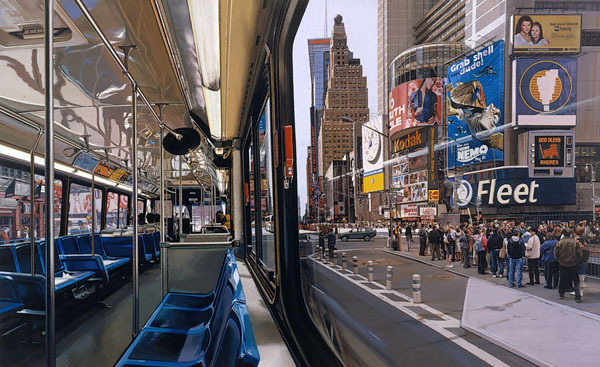
Beginning in the 1960s, the photorealist movement sought to create shockingly lifelike images, usually in imitation of actual photographs. By copying even the tiniest detail a camera could record, photorealist artists were able to produce “an image of an image of life.” The movement, also known as Super-realism or Hyperrealism, encompassed sculpture as well as painting and was heavily influenced by the contemporary pop art movement. But while pop art ironically removed commercial images from their context, photorealism focused on the power of ordinary, everyday life, recreated as accurately as possible.
Influential photorealist artists include Richard Estes, Audrey Flack, Robert Bechtle, Chuck Close, and sculptor Duane Hanson, who have all produced art amazingly realistic enough to leave you questioning if your whole life has been a lie. The movement is usually not a hit with art critics, who often believe it elevates sheer mechanical proficiency over ideas and style.
8Dirty Car Art
Drawing in the dirt caked over an unwashed car doesn’t generally have a reputation as great art—most participants aspire to little more than “wash me” or, at the height of creativity, “I wish my wife was this dirty.”
But a 52-year-old American graphic designer named Scott Wade has become famous for his amazing drawings, created using the dirt found on car windows. Wade started out using the thick layers of dust from local Texas roads as his canvas, and originally sketched cartoons using his fingers, fingernails, and twigs. Nowadays, he uses a paint shaper and brushes to make a variety of complex and spectacular pieces.
Wade has been featured at art shows and hired by advertisers to display his skills at their events. While he prefers to work on glass covered by several layers of dirt, he often uses oil and a hairdryer to prepare a car for one of his live appearances.
While dirty car art is a relatively new style with only a few upcoming artists, the days of “wash me” may be coming to an end.
7Body Fluid Art
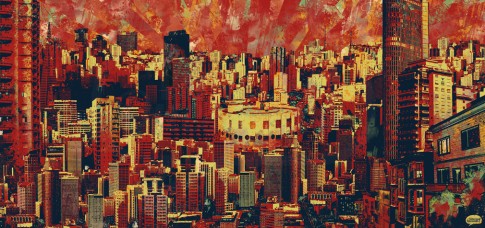
It might seem bizarre, but so many artists are creating works using bodily fluids that we’ve done a whole list about it in the past. But that was just the tip of the disgusting iceberg. For example, Austrian performance artist Hermann Nitsch uses urine and copious amounts of animal blood in his work, producing extremely gory results. His performance pieces, influenced by his childhood during World War II, have caused controversy and even multiple court trials over the years.
Brazilian artist Vinicius Quesada is well-known for a series of body fluid paintings titled “Blood Piss Blues.” Quesada only works with his own blood, refusing donations or animal blood. His paintings, in sickly shades of red, yellow, and green, create a bleak, surreal atmosphere. Some of his notable individual works are Mr. Monkey, which features a cigar-smoking monkey with glasses made from a Nintendo game controller, and Telemptyness, which shows a boy’s obsession with television.
6Painting With Body Parts
And it’s not just using bodily fluids that’s on the rise—artists who use parts of their own bodies to paint with are also steadily increasing in popularity. Take Tim Patch, who goes by the name “Pricasso” in homage to the great Spanish painter, Pablo Picasso. And also because he uses his penis as a paintbrush. The 65-year-old Australian artist doesn’t like to be limited though—he uses his butt and scrotum as well. Patch has been following his unusual muse for well over a decade, and his popularity only seems to be growing.
There is also Kira Ayn Varszegi who uses her breasts to paint abstract portraits. Although she has been criticized as gimmicky, Varszegi is an actual working artist and paints full-time (she also paints without using her breasts).
Other artists in the strangely crowded field include Ani K., who paints with his tongue, and Stephen Murmer, a schoolteacher who paints with his bottom (and faced losing his job over it after students and school officials found out). Perhaps the strangest is Norwegian artist Morten Viskum, who reportedly paints with a severed hand.
5Reverse 3-D Imaging
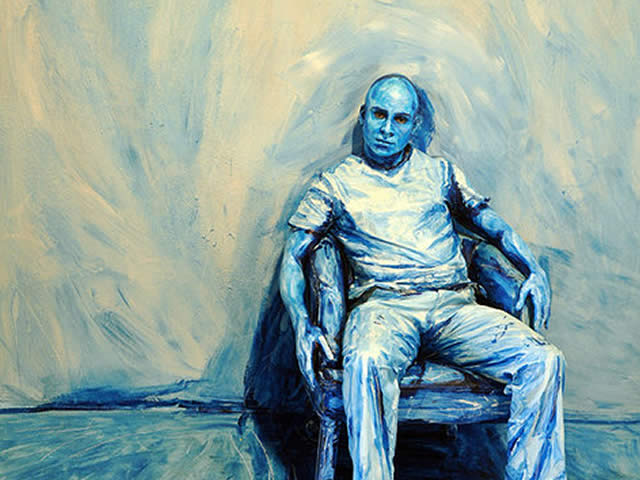
While anamorphosis seeks to make two-dimensional objects appear three-dimensional, reverse 3-D imaging tries to do the opposite—to make a three-dimensional object look like a drawing or painting. The most notable artist in this area is Alexa Meade. Based in Los Angeles, Meade uses non-toxic acrylic paint to make her subjects look like inanimate, 2-D paintings. She began developing the technique in 2008, although she only unveiled it publicly in late 2009. Meade’s works generally involve a human subject sitting against a painted wall to give the appearance of a canvas, and can take several hours to complete.
Another popular figure in the field is Cynthia Greig, a Detroit-based artist and photographer. Unlike Meade, Greig uses ordinary household items as her subjects, coating them with white paint and charcoal to create an illusion of flatness.
4Shadow Art
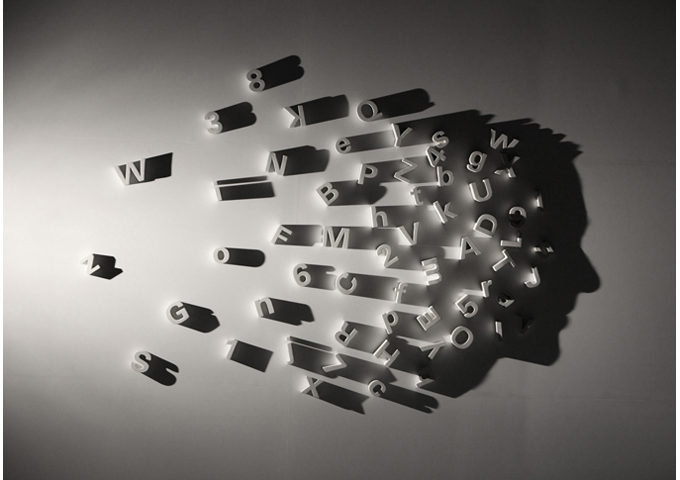
Shadows are fleeting by nature, so it’s hard to say when humans first started using them to make art, but modern shadow artists have certainly taken things to spectacular new heights. Shadow artists use carefully positioned objects to cast beautiful shadow images of people, words, or places. Notable artists in the field include Kumi Yamashita and Fred Eerdekens.
Of course, shadows have a somewhat creepy reputation, and many shadow artists incorporate themes of horror or urban decay into their work, notably the team of Tim Noble and Sue Webster. Among their best-known pieces is Dirty White Trash, which uses a pile of dirty white trash to cast a shadow of two people smoking and drinking. Another work creates the shadow of a bird, possibly a raven, feeding on two severed heads planted on stakes.
It’s not all doom and gloom though. Shadow artist Rashad Alakbarov uses bright, colorful glass to reflect spectacular images onto an empty wall.
3Reverse Graffiti
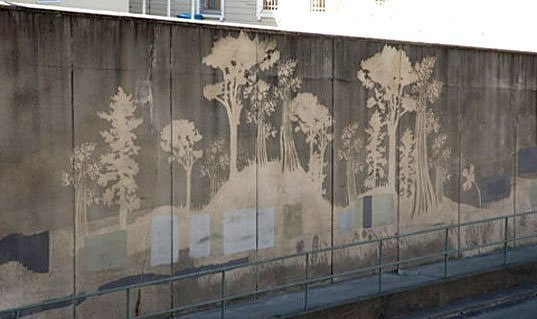
Similar to dirty car art, reverse graffiti involves creating art by removing dirt, rather than adding paint. Artists often use power washers to remove the grime left on walls by car exhaust fumes, creating beautiful images or patterns in the process. Also known as “clean tagging,” the movement originated with English artist Paul “Moose” Curtis, who was inspired by the nicotine-stained walls of a restaurant where he washed dishes as a teenager.
Another British artist is Ben Long, who practices a slightly lower-tech version of reverse graffiti than Curtis. Long creates temporary images on the back of trailers by using his finger to remove the grime from the trucks’ exhaust. His drawings can last a surprisingly long time—up to six months if they are not removed by rain, vandals, or truck drivers—allowing them to reach a potentially huge audience of motorists.
Surprisingly, reverse graffiti has proven somewhat controversial. Paul Curtis has had several run-ins with the police, which he compares to “arresting someone for writing in the sand with a stick.”
2Body Art Illusion

Body painting has been around for a long time—everyone from the Maya right back to the ancient Egyptians tried their hand at it. Body art illusion puts a modern twist on the ancient practice. As the name suggests, body art illusion involves painting a human canvas to blend in with a background or otherwise deceive onlookers.The illusions range from people painted to look like animals or cars to more subtle, disturbing imagery, like gaping holes in their skin.
Hikaru Cho is an acclaimed Japanese body artist known for her unusual, cartoon-like illusions. Other notable artists include Johannes Stoetter and Trina Merry, who has mastered the art of camouflaging her subjects.
1Light Painting

Oddly, some of the first practitioners of light painting weren’t trying to make art at all. Frank and Lillian Gilbreth (subjects of the novel Cheaper by the Dozen) were famous for increasing the efficiency of industrial workers through time and motion studies. In 1914, the couple began using lights and a camera with the shutter wedged open to record the movements of individual employees. By studying the resulting light images, they hoped to find ways to make work simpler and easier.
The method moved into the art world in 1935, when the surrealist artist Man Ray used an open camera shutter to take a picture of himself surrounded by swirling lights. These were thought to be random squiggles until 2009, when it was discovered that they were actually a mirror image of the artist’s signature. Following Man Ray’s lead, the new style was further developed by artists and photographers such as Gjon Mili, Henri Matisse, Barbara Morgan, and Jack Delano—even Pablo Picasso briefly dabbled in it.
Modern light artists include Michael Bosanko, Trevor Williams, and Jan Leonardo. With light painting becoming something of an online trend, it seems the art form has a bright future ahead of it.
John Forbes is a young freelance writer with a passion for the weird and unusual.








